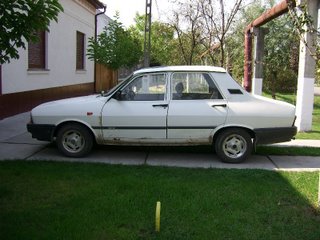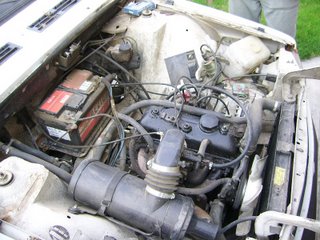of the company.
Dacia, the brand around which the Romanian auto industry
was created and developed, came into existence in 1966, at
Colibasi, Arges district. A close cooperation evolved between
Dacia and Renault from the very beginning. Dacia has been
an integral part of the Renault Group since 1999 and it is
currently becoming more and more visible as an international
brand. In 1998, the anniversary year of three decades since
producing the first ever Dacia car the vehicle number
2,000,000 came out of the plant.
This is not to say that the Dacia is the only car here, there is
about any make of automobile that anyone would want. It is
just that this car is what my brother-in-law would call ’A Classic’.
As you can see by my neighbor’s 1998 4-door.

This one is actually pretty ‘misto’ Rroma/Gypsy word for
‘cool’ because of the wheels. The owner of this ‘classic’ Dacia
is Mr. Pavel. He’s had this one for about 8 years because he
bought it brand new in ‘98‘.

This photo almost puts you behind the wheel of a ‘98‘ Dacia.
Below you can see what powers the Dacia on and off road,
you see these cars going everywhere. One advantage to the
older Dacia is that they are very economical to repair. But as
someone mentioned ... if you have to repair it weekly, is it
really that economical? Probably that is why it is not unusual
to see 20 year old cars still motoring down the highways and
traversing fields.

The power plant is a four cylinder and I have seen some that
run on propane. What they do is place a propane tank in the
trunk and people have mentioned that it costs almost 50% less
than regular fuel, here fuel is called ‘benzina‘. Mr. Pavel’s Dacia
is not propane powered.
It is kind of funny how a vehicle kind of relates to one’s Peace
Corps experience. In El Salvador it was the ‘chicken buses’ …
the brightly painted and decorated old yellow school buses with
Salsa style music blaring. In Senegal it was the Peugeot station
wagon that was called ’7-palaas’. Both of those being the main
modes of public transportation. Though the Dacia isn’t a means
of public transportation it is similar to the others as just the
mention of it's name will forever trigger memories of Romania.

Older models of the Dacia, the typical four door and station wagon
A few volunteers from the Senegal tour would mention that when
they returned to the States, they had this crazy desire to buy
a Peugeot station wagon. Some even looked on E-Bay and found
some. Don’t know if they bought any. But you know, having a
little Dacia wouldn’t be that bad a thing. Also seeing that it is
becoming an international brand I may be able to buy a brand new
one. Right there in the ole USA.
No comments:
Post a Comment